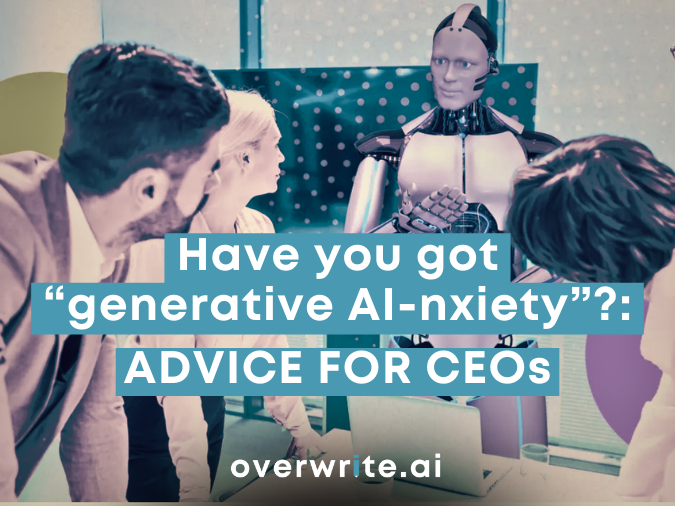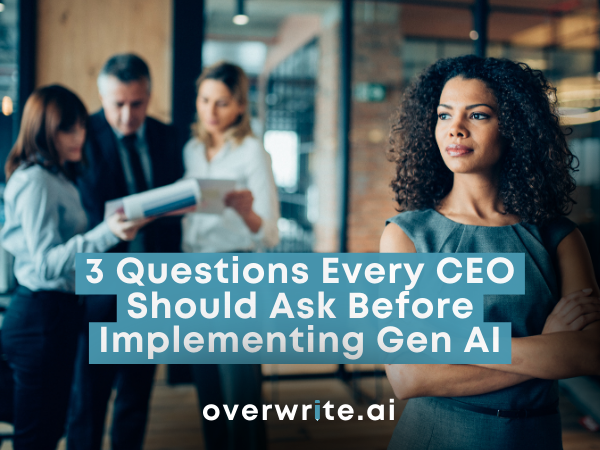Many CEOs and business owners are feeling pressure to incorporate generative AI into their plans. If the pressure doesn’t come from an industry rival, it often comes from your own board.
Ready or not, be prepared to adopt it carefully, intentionally, and soon!
BIG DEMAND, BIG BENEFITS
Most companies have already implemented generative AI or are working to do so soon. Tellingly, even organizations in the early stages of maturity are seeing benefits. In fact, 89% of companies currently using generative AI reported seeing either substantial or modest upsides from the technology.
The three most frequently reported benefits?
- Increased market competitiveness (52%)
- Improved security (49%)
- Enhanced performance or functionality of their products (45%)
Here are three steps as you put together your generative AI strategy.
1. Clarify Leadership
What separates companies actively using generative AI from those that can’t seem to get things off the ground? In a word: leadership. Remarkably, 98% of surveyed companies using generative AI today report having a single organizational leader that drove the adoption.
And while you may tap your CTO or Head of Analytics to oversee the adoption, never underestimate your own importance in making it stick. According to the data leaders in our survey, the most common role responsible for driving generative AI strategy is the CEO. You and the leader you appoint will both play a big part in rollout strategy as well as things like allaying fears and concerns of employees and board members.
My advice to my fellow CEOs is simple: Empower one leader to take the reins with your generative AI efforts. Give them clear direction, guidance, and support in achieving that goal, and help them build a team with the skills they need to make it a success.
2. Start Slow
All the pressure being heaped on CEOs to adopt generative AI may be somewhat warranted, but it can have the unfortunate outcome of causing you to act hastily. Don’t take the bait. Instead, take this process at the right pace and allow yourself to experiment before diving into the deep end. You’ll be glad you did.
While 36% of surveyed data leaders say their organization is currently using generative AI, just 13% of those leaders rate their maturity as “optimizing” or “innovating.” The remainder rank their generative AI maturity as still in the stages of exploring, experimenting, or formalizing. In other words, there’s still time to catch up.
If you and your team are feeling like you’re behind the curve, don’t fret but do make sure you are laying the groundwork now. Before you jump in, identify what use cases would make the biggest impact and the most sense in your organization. Some of the most popular use cases named by our respondents include:
- Content generation
- Analytic insights summary and generation
- Code development
- Process documentation
3. Manage Risk
Are there clear risks to using generative AI? Of course. There are particular concerns around things like data quality and security. But there are enormous upsides, too, and there are tried and true ways to mitigate those risks.
Some 77% of the board members we surveyed said their organization has policies or guidelines in place to address ethical concerns around generative AI. Likewise, 75% say their organization is currently addressing regulatory or compliance considerations around generative AI.
Providing organizational guidance is key to mitigating risk. A solid majority of the board members we surveyed said they are already doing this around topics like privacy and security, fairness and bias, trust and transparency, social impact, and accountability. Many organizations are now conducting regular AI audits and establishing clear lines of responsibility for generative AI management in order to ensure proper governance and ethical use. And for organizations that don’t yet have those skills in house, working with trusted vendors can add another layer of security and risk reduction.
Given the moment we’re in, CEOs are forgiven for feeling a little anxious when the topic of generative AI comes up with their board. But the fact is, if you empower the right people, take your time, and take steps to mitigate risk, you can unlock some serious benefits for your company and turn that anxiety into pure exhilaration.
This column does not necessarily reflect the opinion of overwrite.ai and its owners.
Mark Anderson writes for Fast Company
This story has been published from an article in Fast Company published on 31st October 2023.
For informative news and views on the world of real estate, proptech and AI, follow overwrite on Instagram and LinkedIn, and keep up-to-date with our weekly NewsBites blog.
About overwrite.ai
overwrite.ai is a pioneering, purpose-built real estate AI, creating engagement-oriented content for the real estate industry. overwrite.ai creates the marketing content that powers the real estate industries of the UAE, KSA, Egypt and Lebanon.
overwrite | real estate content creation, reimagined

























